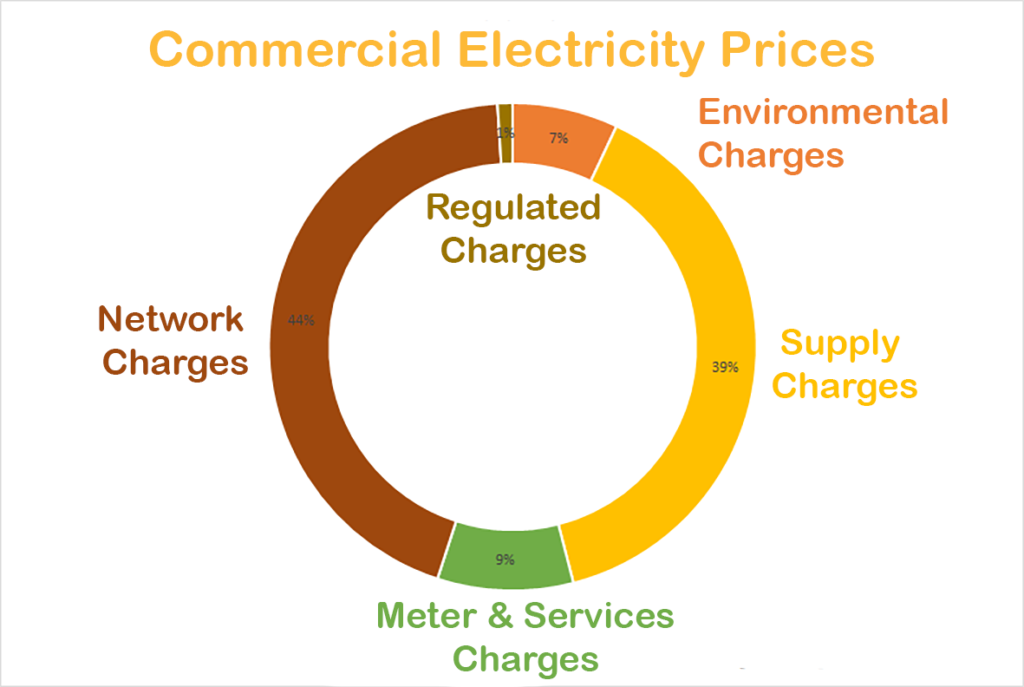The most common frustration I hear from business owners who have installed solar is results do not meet expectations. With the amount of data available, however, engineering a quality solar installation with a clear and measurable outcome should be straight forward.
When there is a question about performance asked what we find it is usually the solar company, and in particular the salesperson, that has made claims about potential savings which are just not realistic. Only rarely is it a poor installation or poor-quality equipment.
One of the reasons for this is the salesperson, often used to dealing with small systems, may not understand how to read a commercial power bill or understand which parts of the commercial power bill a solar solution may have an impact on.
In this article I address how to read a commercial power bill, how best to size a solar system to maximise savings for your client and provide a clear measurable outcome.
What is your electricity bill is made up of?

A commercial electricity bill is made up of five components
- Supply charges
- Network charges
- Regulated charges
- Environmental charges, and
- Metering and Services charges
Here is a quick guide to the components that make up a commercial electricity bill and how solar could impact them.
Energy Supply Charges
Energy supply charges refers to how much you are charged for the electricity you source from the grid. This is simply a rate, usually indicated in cents per kWh, multiplied by the kWh consumed.
Smaller businesses tend to have a single rate tariff, the same as a household. This means they pay the same price for electricity regardless of the time of day you use it.
For most larger commercial users, however, this is broken up into a peak rate, shoulder rate and an off-peak rate, depending on your location and time of power consumption.
- In NSW, on weekdays, peak rates are from 2PM to 8PM, shoulder rates from 7AM to 2PM and off peak from 8PM to 7AM. Weekends are shoulder and off peak rates only
- Victorians are charged peak electricity usage rates between 7am and 11pm, Monday to Friday, with off-peak rates applying at other times, including weekends.
- Peak usage rates in SE QLD apply from 4pm to 8pm, with off-peak hours of 10pm to 7am. Shoulder rates apply from 7am to 4pm, and 8pm to 10pm.
Check with your local retailer for Peak, Shoulder and Off-Peak times. These examples based on January 2020 rate charts.
Solar impact
Solar can produce electricity during the morning shoulder and afternoon peak only, with maximum production for a properly tilted system occurring early afternoon. For a business operating 8AM to 4PM seven days a week solar can replace a significant portion of their energy supply charges. For consumption outside these times, especially in the winter, your business will need to purchase power from the grid.
Network Charges
This is the fee charged to get an electron from the generation source to your premises. This is the ‘poles and wires’ that carry electrons to your premises.
Network charges may rival energy supply charges for making up the largest portion of your bill. Network charges are paid to the transmission and distribution companies and include daily fixed network access charges, time of use charges applied per kWh and demand charges.
Demand charges are included in this category. Demand relates to your business’ highest 30-minute interval of demand within a given period (usually monthly) and measured in kilo-volt-amperes (kVA). This charge is to provide your business with enough power to operate at the point of highest demand, even if that demand is only for one 30-minute period in a month.
Demand charges can make up most of your electricity bill so careful planning is required so these charges can be reduced.
Solar impact
Assuming your solar is generating electricity onsite, there is no cost to transport the electricity to your promises. This means you eliminate the network charges for all power produced onsite.
Demand charges, however, are difficult to reduce and if the installation & consumption profile is not designed properly, might not be impacted at all by solar. This is the biggest area of frustration with small solar vendors, with limited commercial experience, who may not take the time to engineer the ideal commercial solar solution.
Regulated Charges
Participant Charge
This is a ‘Thank you for coming’ charge. A bit like a ticketing company charging a fee to manage the booking process.
This charge is paid to the Australian Electricity Market Operator (AEMO) to cover costs associated with running the National Electricity Market (NEM). The NEM is busy matching electricity supply and demand across one of the largest interconnected power systems in the world. In real-time. 24/7. It is a big job and the costs are distributed across all market participants.
Ancillary Services
Ancillary services are support services the AEMO must purchase from generators to keep the whole system happy. Power grids are sensitive beasts and the frequency in all those wires needs to be kept within a tight band around 50 Hertz. AEMO charges a fee for maintaining system frequency and these costs are passed on to all users.
Solar impact
Assuming your solar is generating electricity onsite, there is no participant or ancillary charges for the electricity you generate and consume.
Environmental Charges
There is a range of Federal and State schemes that affect your energy bill. The Large Scale Renewable Energy Target (LRET) and Small Scale Renewable Energy Scheme (SRES) oblige retailers to purchase renewable energy certificates that correspond to renewable energy generation. These costs are passed on to consumers at a per kWh rate determined by the price of certificates.
Solar impact
Assuming your solar is generating electricity onsite, there are no environmental charges for the electricity you generate and consume.
You may, depending on your location, apply to sell surplus electricity back to the grid via your electricity retailer. This is called the FiT (Feed in Tariff) and varies from state to state and may also be impacted by local grid conditions. It is not a guaranteed income but can help offset some of the cost of solar.
Once installed, depending on the size of the installation, you will be creating renewable energy certificates for others to purchase. For installations under 100kW you will typically receive this as a discount on your installation. For larger system you will receive ongoing income depending on actual production and the price of the certificates at the time of sale.
Metering and Services Charges
Meter Charge
The meter charge covers the cost of installing, maintaining and reading your meter. Newer smart meters are more expensive to install but can deliver savings through displacing the need for field technicians. Meter charges are fixed costs that are applied to your bill as a daily rate.
Retail Supply Charge
This is the part your energy retailer keeps covering the cost of administering your account. Everything from the electricity traders that purchased your power in the wholesale electricity markets to the envelope that your bill arrived in is contained in this price.
Solar impact
Assuming your solar is generating electricity onsite you might eliminate some of the retail supply charges, but not the meter charge.
Designing your ideal solar solution
With the advent of smart meters most commercial installations will be able to access at least 12 months of consumption data (this is the detail of your electricity usage, broken down into 30-minute intervals over 12 months). This information, along with your most recent bill, is critical to providing you with real information on potential savings and your ideal solar size.

In this study, we can see the historical consumption of electricity over the last 12 months (black) is reasonably consistent every day of the week with Saturday and Sunday missing the small ‘peak’. Installing the recommended solar replaced a very large chunk of the daytime usage (yellow) with minimal export (green).
 In this second study, we can see the historical consumption of electricity over the last 12 months (black), while reasonably consistent every day of the week, has a peak in the early evening. Installing the proposed solar will replace most of the daytime usage (yellow), however, most of the production will be exported (green) and demand charges may eat up all the savings. As this proposal is in a state where there is no feed in tariff the exported electricity is wasted. If this commercial client were to proceed with the proposal ‘as is’ there is a high likelihood of disappointment in their savings.
In this second study, we can see the historical consumption of electricity over the last 12 months (black), while reasonably consistent every day of the week, has a peak in the early evening. Installing the proposed solar will replace most of the daytime usage (yellow), however, most of the production will be exported (green) and demand charges may eat up all the savings. As this proposal is in a state where there is no feed in tariff the exported electricity is wasted. If this commercial client were to proceed with the proposal ‘as is’ there is a high likelihood of disappointment in their savings.
Demand a quality proposal
Assuming you are considering solar and, most likely, considering if a finance solution like an operating lease or power purchase agreement is suitable, you will want to ensure you have the right information to make that decision. I do not want to be receiving difficult calls from business owners who have installed solar not meeting expectations. We take the time early to extract the data and work with your solar vendor to engineer a quality solar installation with a clear and measurable outcome.
Action points
- Call ASM Money to receive help to get your data
- Ask your vendor to produce real savings information using your actual data, not just bills.
- Understand the ideal finance solution. You do not need to pay for the poles and wires coming into your building and you should not need to pay for your solar either.




